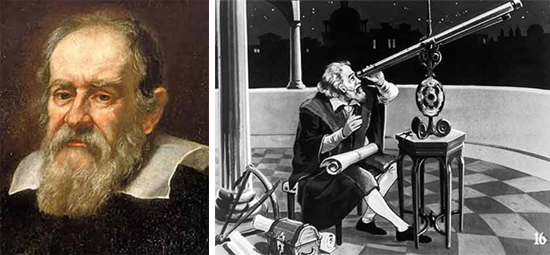Apr 15, 2025
Apr 15, 2025
The first astronomer to make systematic use of a telescope was Galileo Galilei (1564-1642), who ushered in a new era in the history of astronomy. Born in Pisa, Italy, he was the son of Vincenzo Galilei, a mathmetician. As a student of physics in his teens he wrote a treatise titled "Specific Gravity of Solid Bodies". At the age of 24 he became a professor of methematics at Pisa. Here he postulated the theory that objects of different weight fall at the same speed. He proved it through a now famous demonstration from the top of the Leaning Tower of Pisa from where he dropped a metal ball and a wooden ball at the same time. Both hit the ground simultaneously.

Between 1592 and 1610, Galileo worked as a professor at the University of Padua, and in 1609 he developed a telescope as an improvement of the one invented by Hans Lippershey (1570-1619) in the Netherlands. Using his telescope on January 7, 1610 he discovered four great Moons of the planet Jupiter. Later, he studied the surface of the Moon and discovered sunspots on the surface of the Sun, which proved that it rotated on its axis.
Galileo publicly defended the theory postulated by Nicholas Copernicus which enunciated that the Sun was the focal point of the orbits of the Earth and the other planets, and that the Moon only revolved around the Earth. Thus, the Sun and not the Earth was the centre of our solar system. The Catholic Church which held the opposite view, forbade Galileo to teach or publish his ideas. In spite of that he published his work titled "Dialogue on the Two Principle World Systems" in 1632, which incurred the wrath of the Church. As a result Galileo was placed under house arrest, and lived as such till the end of his life near Florence. On January 8,1642 he died nearly blind as he indulged in observing sunspots with unprotected eyes. On October 31,1992, three hundred and fifty years later Galileo's theories were proudly acknowledged by Pope John Paul II.
History has it that 400 years after Galileo first demonstrated his telescope to scholars on a Roman hilltop, and the astronomer was condemned by the Catholic Church, was celebrated on the same spot with a multimedia art exhibit, which also included an installation from the Vatican as an honour to the great scientist. This event took place on Thursday night on April 14, 2011 at the American Academy in Rome.
Against all odds Galileo made the first astronomical telescope, and used it to gather evidence that the Earth revolved round the Sun. Church teaching at that time placed the Earth at the centre of the Universe. Galileo's theory was denounced by the Church and declared as a danger to the Faith. Galileo defied all warnings. Was tried for heresy, and forced to recant in 1633, and spent the rest of his life under house arrest. May be, it is 400 years late, but the Vatican with Pope Benedict XVI in command honoured Galileo his labour and work on April 14, 2011
12-Nov-2011
More by : Dr. Frank S. K. Barar